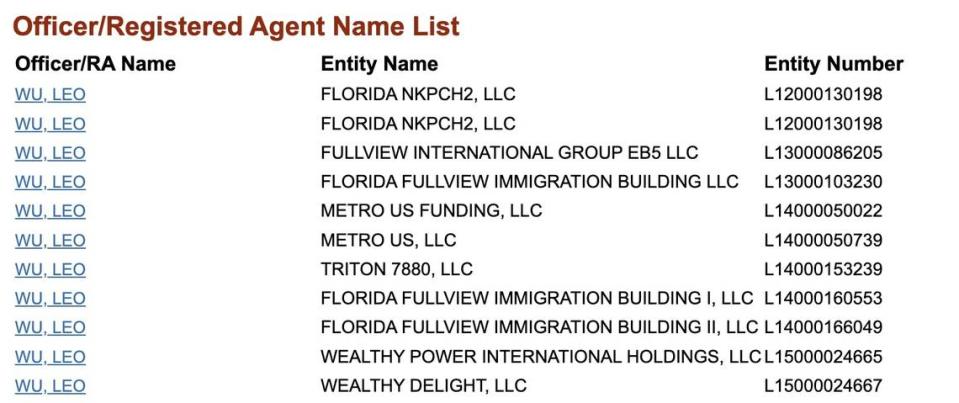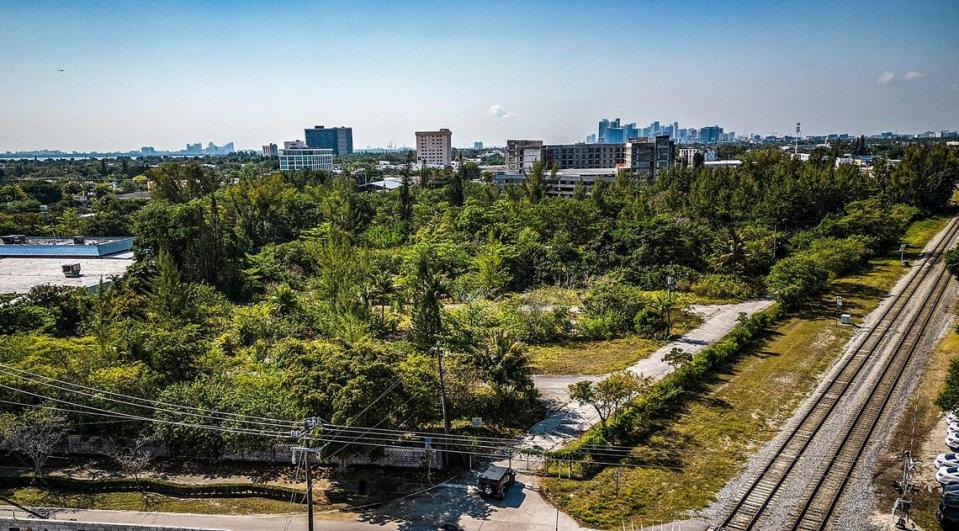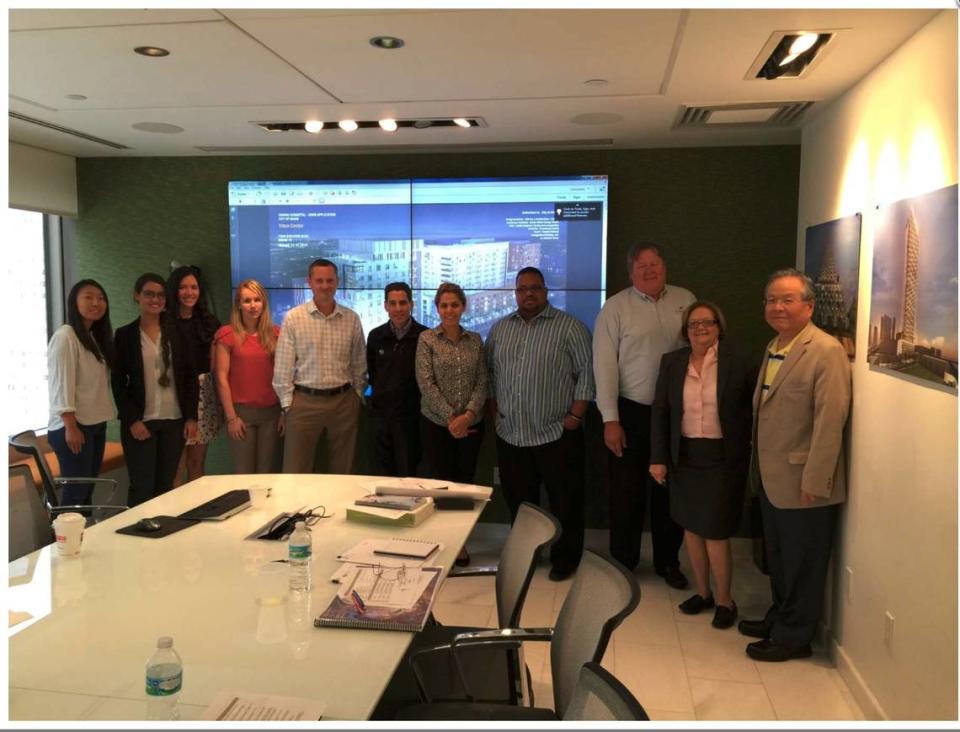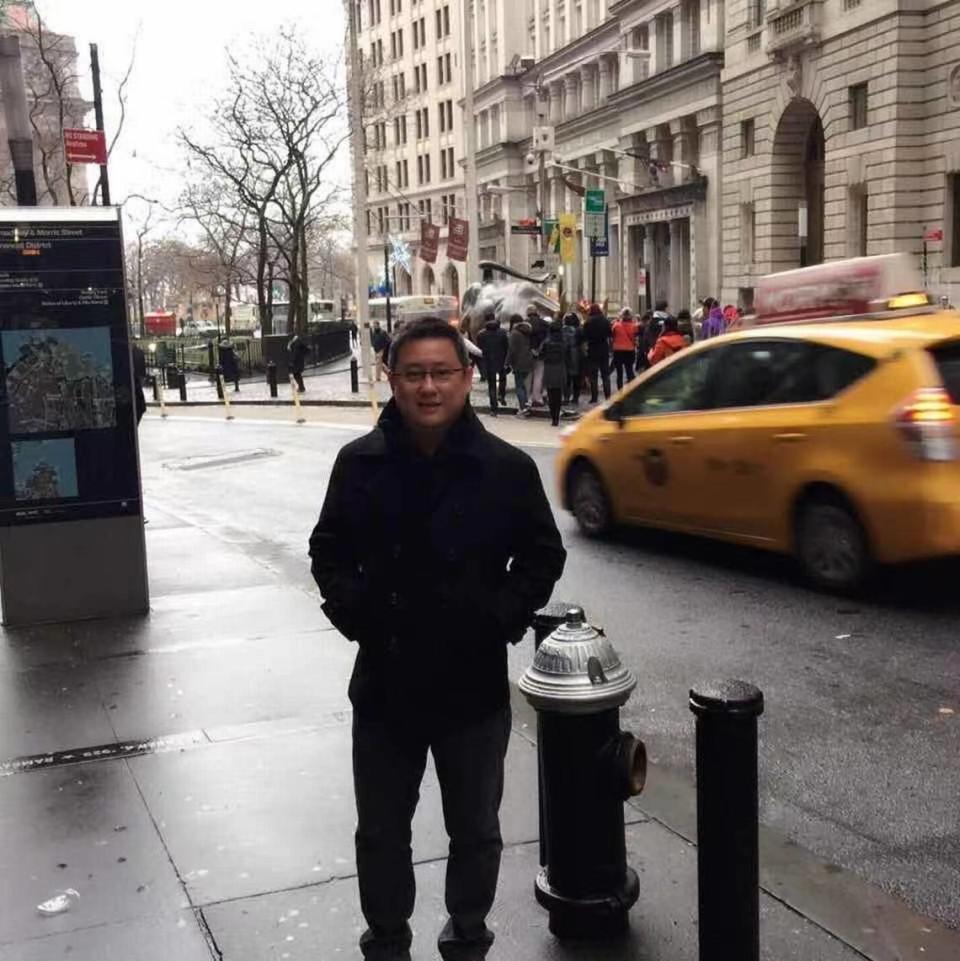Money pit: How an overhaul of Miami’s former immigration building became an epic disaster
The building stands empty and skeletal, a behemoth overlooking Biscayne Boulevard and 79th Street.
But the old Immigration and Naturalization Service tower at 7880 Biscayne Blvd. was once a bustling swarm of activity, with long lines, befitting Miami’s role as an international hub of migration and overseas travel.
For going on 15 years, even as neighboring Biscayne Boulevard was transformed from a stretch of drab convenience stores and blighted motels into trendy boutiques and restaurants, the structure has stood like a grim tombstone — even getting tagged with an unsafe structure notice in 2021 — despite plans for a sparkling rebirth.
Those plans have thus far resulted in epic failure, with tens of millions of dollars lost in a game of whack-a-mole involving an array of opaque limited liability corporations. That alleged financial sleight-of-hand has spawned lawsuits, including one filed this past month, positing fraud and deception. Tangled up in this saga are the hopes of Chinese investors with a dream of coming to the United States with their families, and the frustrations of the town of El Portal, located a few blocks to the north of the empty structure.
READ MORE: Officials in Miami suburb fume as shuttered trailer park is tangled in weeds, litigation
The story that emerges from court documents is one of financial finagling on a grand scale, involving something called an EB-5 visa.
The best of intentions
It all began with the loftiest of intentions, at least among those who put up the money. Chun “Peter” Liu was one of them. Seeking a better life and education for his son, who was 12 at the time, Liu attended a convention in the city of Guangzhou in his native China.
There, he heard a pitch to invest in a project half a world away, a plan to revamp a Miami building that had fallen into decay. The building had an interesting history even before serving as Immigration and Naturalization Service headquarters. Initially, it was home to the now-defunct Gulf American Land Corp., infamous for peddling Florida swampland to northerners. Topped by concrete fins, it featured a Times Square-style news “zipper.”
During its heyday as an immigration hub, the building was the scene of long lines and frequent flag-waving demonstrations. When it closed in 2008, no one thought it would be an empty vessel for the next decade and a half.
It was apt that the money to refurbish the structure would have a connection to immigration.
In exchange for putting up $500,000, Liu and his family could claim green cards — permission to live and legally work in the United States — through an EB-5 investor’s visa, provided his money could be shown to create 10 permanent jobs. The project, called the Triton Center, would be a mixture of hotel rooms, apartments and ground-floor retail space.
The artists’ renderings were impressive.

Liu not only kicked in the $500,000, but an extra $50,000 for administrative fees, mortgaging his home to scrape together the cash. He was among 100 investors who made similar commitments.
The Triton Center was supposed to be finished by 2021. It literally never get off the ground.
“Work has been at a standstill for a while,” said Asael Marrero, the city of Miami’s building director. Marrero also confirmed that the permit to do foundation work was never finished and the master permit was never pulled by the owners.
Liu, one of the few investors to gain permission to come to the United States thus far, sued in October 2020, naming the project’s funding arm, something called Florida Immigration Building Funding LLC, along with its then-manager, Wai Kin “Benny” Lam.
The case landed on the docket Circuit Court Judge Michael Hanzman, later known for his stewardship of the complex Surfside building collapse litigation. As with Surfside, Hanzman appointed a receiver named Michael Goldberg.
Goldberg then filed an ancillary complaint, alleging that two men, Lam and Fu Jing “Leo” Wu, worked in concert to engineer an elaborate fraud, siphoning millions from the project into offshore shell companies with names like Procam Overseas Co. ($2,694,790), East Coast Travel ($3,361,750), Canadian Education Capital ($1,106,860) and Great China Group ($1,000,000). Those corporations had nothing to do with the INS building, he said. According to Goldberg’s legal petition, another $700,000 was diverted to Lam and $8,871,320 went to a separate company controlled by Wu.
According to court documents filed by Goldberg, Benny Lam was sort of a figurehead and Wu held the real power.
Who is Wu? According to Florida corporate records, he is an officer or registered agent of 11 Florida companies. At least four are tied to the Triton project, all of them now inactive. According to court records, a fifth company, Wealthy Delight LLC, played an important role in redirecting money meant for the Triton project.

The diversion allegedly worked like this: Little Farm trailer park was a fixture in nearby El Portal, on land wedged between Biscayne Boulevard and the FEC tracks to the west. Nestled in a single-family-home community that had seen property values rise, Little Farm was an anomaly, a trailer park that had seen better days. It was purchased in October 2014 by a mysterious entity for $13,580,000. That mysterious entity was Wealthy Delight, the firm run by Leo Wu. Wealthy Delight wasn’t about to operate an El Portal trailer park for long. It embarked on a mission of mass eviction, so the land could be profitably redeveloped.
Years after the last resident was forced out, the land sits idle and choked with weeds, to the great disappointment of El Portal political leaders, who hoped to see the property developed and taxes generated.

Triton’s lawyer objects
Moving the money from the Triton Center to Little Farm was a bridge too far for the Triton project’s attorney, David J. Hart.
According to court records, Hart “demanded” that Wu and Lam replenish the funds or he would cease representing the project and “advise investors and USCIS of this fraud and breach of fiduciary duty.”
Wu and Lam responded aggressively, sending a letter to absentee investors saying Hart was lying.
In the end, the more than $13.5 million of Triton money remained right where it was: invested in Little Farm. Hart, who could not be reached for comment, would no longer represent Triton.
Ambitious development plans dissolving into acrimony and litigation are nothing new in Miami-Dade and investors can and do lose money. What is unusual about these projects is that those left in the lurch were powerless pawns, mostly stuck in China, their prospects of coming to the United States ever dwindling.
Their best hope was Goldberg, who is renowned in the field of receiverships. He became the receiver for both properties, the 79th Street lots and the Little Farm acreage, hoping to recover the investors’ money through a sale.
Neither Wu nor Lam would make themselves available for comment. Although tangled in complex court litigation, neither faces any sort of criminal charges.
The EB-5 program
EB-5 visas are a way to encourage foreign nationals with money to invest in the United States. The program was created in 1990 by Congress as a way to stimulate the U.S. economy. South Florida has had its share of EB-5 success stories. Among them are the Panorama Tower in Brickell and Tap 42 Craft Kitchen and Bar.
But EB-5 investments have proven susceptible to fraud. In the Jay Peak case, one of the more well-known fraud cases, a Key Biscayne man played a central role in one such fraud. Ariel Quiros was accused of misappropriating tens of millions in investor funds that were initially intended to build a biotechnology plant in Vermont. Prosecutors said the money ended up at least partially in Quiros’ pockets.
Called the “mastermind” behind the largest fraud in Vermont history, Quiros is serving a five-year prison sentence.
The EB-5 program has evolved over the years, in an attempt to make it more resistant to fraud. It has also become more expensive. The minimum investment for foreign nationals to qualify for a green card is now $900,000.
One percent of nothing
By virtue of sinking $500,000 (plus $50,000 in incidentals) into the project, Liu got 1% stake in the project.
He was told it was going to be a “big building” with a “bright future.”
At least the plans were big and bright. By 2015, the services of the design firm ADD Inc. had been secured. The firm was later absorbed by another, Stantec.
Ben Carter, the public relations lead for Stantec, told the Herald that the company did its part, “completed 100% documents, submitted for permit to the city & addressed city comments.” Progress ended there, however, and the permits eventually expired.
As one of the few investors to have received permission to come to the United States, Liu was fortunate. Others remained stuck in China, where the wait for investors to be issued their EB-5 visas in the event of a successful project has gone from three years to roughly 10. But even Liu felt vulnerable, fearful that his residency could be rescinded.
He asked to see Triton’s books, according to court records and testimony from Liu, but hit a wall. He wanted to contact other investors, but was unable to determine who they might be. He felt he was being deliberately kept in the dark.
All that existed of the Triton Center was its website, festooned with impressive renderings. Then, as now, it listed an email address, a telephone number — since disconnected — and a physical address in its “contact us” section. It offered renderings, an out-of-date timeline for completion of the project and an assortment of “events” that include photos showing Wu, who lives in Canada, meeting with consultants.
Where did the money go, Liu wanted to know.

“I just felt so helpless as a new immigrant,” said Liu. “We had a strong feeling there was something wrong.”
Into the courts
And so Liu sued. The complaint filed in October 2020 sought compensatory damages and an injunction to get Lam to stop doing business on behalf of the company. He also demanded access to the company’s books and important immigration documents to which he hadn’t had access.
The animosity lingered during the lawsuit, with the company sending reports to the court from China questioning Liu’s character and the validity of his statements, according to Liu and his lawyer and court documents.
Meantime, Judge Hanzman was having trouble getting Lam to cooperate. He threatened to hold Lam in contempt, court records show.
That’s when Hanzman brought in Goldberg as receiver.
“There is good cause to believe that immediate and irreparable harm will result from Benny Lam’s ongoing violations of his fiduciary duties to the Company and its members unless Defendants are restrained and enjoined by order of this Court,” Hanzman, who resigned from the bench this past week to return to private practice, wrote at the time.
In a discussion on WeChat, a Chinese social media platform, Lam tried in vain to get the receivership rescinded. He said it was not in the best interest of the investors and argued that it would put the money and immigration status of the investors in jeopardy.
Some of those investors did sign a petition asking for Goldberg’s removal and Lam’s reinstatement. That effort flopped. In the end, Goldberg was able to get Lam to provide over 2,000 pages of documents and answer Goldberg’s questions during a Zoom conference, according to court records.

In a court filing, Goldberg would conclude: “Virtually every action by Wu and Lam taken with regard to the Triton Center Property was done with the intent to defraud, and they actively engaged in a pattern of concealment of their fraud.”
Liu and Wu would finally arrive at a settlement in which Goldberg would take ownership of the two properties, sell them and use that money to pay off mortgages on the land and repay at least some of what the investors were owed. Wu would also recoup some money, in line with the percentage that the investors would get of their original $500,000 ante — up to a maximum of $5 million..
“If the victims get 80%, he will only get 80%,” Goldberg told the Herald.
Class action
Last month, another legal shoe dropped. Liu’s attorney, Alexis Read, filed a second lawsuit, this one a class-action suit on behalf of all the investors, naming Wu and Lam and various corporate entities.
Like the complaint brought forth by Goldberg, it alleges fraud and deception by Wu and Lam.
The purpose of this lawsuit, Read said, is to seize the $5 million Wu hopes to gain from the sale of the INS and Little Farm properties and distribute that amount among the investors.
Although the lawsuits are sprinkled with words like “fraud,” there is no indication that a criminal investigation is forthcoming. When asked if the the Securities and Exchange Commission was investigating, a spokesperson said the commission never comments on the existence or nonexistence of a possible investigation.
The United States Citizenship and Immigration Services did not respond to questions from a reporter about the lawsuit.
The power of one
Of the original 100 investors, Liu was the only one willing to sue in the beginning, although others have joined the class action. Most of the others, he said, are still in China and are afraid to speak out.
He said those fears were fed by Lam, who posted messages on WeChat suggesting Liu’s actions, not Lam’s and Wu’s, could torpedo their hopes of getting to the United States and getting their money accounted for.
“People were worried that he [Liu] was jeopardizing the project, when in reality he was just exposing it,” Read said.
Goldberg met with investors virtually to tell them about the settlement he had helped foster and the next steps. He said some of them had no idea what had been happening.
“You thought you were going to come live the American dream and I’m coming in and telling you this was not as you thought and your immigration is probably not going to happen.. And besides that, we have to go out and find your money, because your money is not where it’s supposed to be,” he said of the “sad” conversation he had with the investors.
In EB-5 cases, he said, it’s common for investors who are not yet in the United States to be out of the loop.
“You have this investor body that is naturally quiet and they stay to the side. It’s almost like, you get free rein to do what you want — because the threat is, you’re not going to get your immigration status.”
“It’s very sad. Because I’m dealing with people’s lives. This is not just a $500,000 investment. Your life is 180 degrees uprooted. And your kids, and what you thought you were doing for the benefit of your family is turned away,” he said.
Before, the law required a direct link between the investor’s money and the 10 jobs created by that money. Meaning: If a building funded by EB-5 seeking investors burned down during construction, the insurance money could not then be used to satisfy the job requirement. The process would have to begin anew with a separate financial commitment.
In the Jay Peak case, also involving Goldberg, only the investors who already had conditional residency status were eligible to reinvest their money.
Now, thanks to the law being changed by Congress about a year ago, when an EB-5 project goes awry, as the INS building clearly has, investors can conceivably recover the money, reinvest it in another project and keep their place in line. Goldberg helped get that change introduced and adopted back in 2016, when he was appointed Jay Peak receiver.
The investors for the Triton Center still have a long road ahead.
And there is another potential snag: the increase to $900,000 in the minimum investment to qualify for an EB-5 visa. Goldberg argues that Triton investors acted in good faith and should be grandfathered in under the original but now outdated amount of $500,000.
Goldberg has hired a nationally known immigration lawyer who helped write the original EB-5 law to work on behalf of the investors.
“It’s going to be a fight,” Goldberg said, “but at least we have a path.”
As for the building at Biscayne and 79th Street, all this could remove an impediment to its redevelopment. But it will apparently remain an eyesore for the foreseeable future.
Miami Herald staff writer Joey Flechas contributed to this report.
This article has been updated to correct details surrounding the illegal diversion of millions of dollars raised from foreign investors for an unbuilt biotechnical plant in Vermont.

